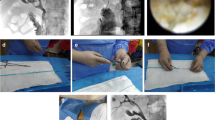Abstract
Purpose
To evaluate the efficacy and safety of percutaneous transhepatic endoscopic holmium laser biliary lithotripsy (PTBL) to treat recurrent cholangitis due to intra/extrahepatic stones, in patients not candidate for traditional endoscopic treatment.
Materials and methods
We retrospectively evaluated 28 patients (M:F = 19:9, mean age = 65 years, SD = 14) undergoing 43 PTBL for stone-related recurrent cholangitis from January 1, 2012 to January 31, 2019 in a single academic center. Data collected included demographics, location and number of stones, clinical success after one (primary) or more than one (secondary) PTBL, procedure time, duration of hospital stay, number of retreatments and post-procedural complications. Clinical success was defined as the resolution of cholangitis at 30-day follow-up.
Results
PTBL were successful for 23/28 (82%) patients, 16 (57%) with one and 7 (88%) with repeat procedures. The remaining 5 (18%) patients were finally treated with surgery (3, 11%) or further antibiotics (2, 7%). PTBL were performed to treat intrahepatic stones (22 treatments, 51%), extrahepatic (14, 33%), and both intra/extrahepatic (7, 16%). One to three stones were found in 12/43 (28%) PTBL, more than three in 31/43 (72%). Single PTBL was performed in 20/28 (71%) patients, two in 3/28 (11%), three in 3/28 (11%), and four in 2/28 (7%). Median procedure duration was 115 (29–210, 95% CI 101–129) minutes; median hospital stay was 5.5 (2–42) days. The only major complication was the breakage of a guidewire tip, surgically retrieved; minor complications included one aspiration pneumonia and three instances of intrahepatic hemorrhage, treated conservatively.
Conclusions
PTBL was clinically successful in the 82% of patients not candidate for endoscopic treatment, with a low complication rate.



Similar content being viewed by others
References
Hong KS, Noh KT, Min SK, Lee HK. Selection of surgical treatment types for intrahepatic duct stones. Korean J Hepatobiliary Pancreat Surg 2011;15:139–45. https://doi.org/10.14701/kjhbps.2011.15.3.139.
Veld JV, van Huijgevoort NCM, Boermeester MA, Besselink MG, van Delden OM, Fockens P, et al. A systematic review of advanced endoscopy-assisted lithotripsy for retained biliary tract stones: laser, electrohydraulic or extracorporeal shock wave. Endoscopy 2018;50:896–909. https://doi.org/10.1055/a-0637-8806.
Ierardi AM, Fontana F, Petrillo M, Floridi C, Cocozza E, Segato S, et al. Percutaneous transhepatic endoscopic holmium laser lithotripsy for intrahepatic and choledochal biliary stones. Int J Surg 2013;11 Suppl 1:S36-9. https://doi.org/10.1016/S1743-9191(13)60011-4.
Li H, Zheng J, Cai J-Y, Li S-H, Zhang J-B, Wang X-M, et al. Laparoscopic VS open hepatectomy for hepatolithiasis: An updated systematic review and meta-analysis. World J Gastroenterol 2017;23:7791–806. https://doi.org/10.3748/wjg.v23.i43.7791.
Jin P, Jing W, Zhan W, Han C, Si M, Yang J, et al. Efficacy and safety of laparoscopic holmium laser lithotripsy in the treatment of complicated biliary calculus: A PRISMA-compliant systematic reviews and meta-analysis. Medicine (Baltimore) 2019;98:e14286. https://doi.org/10.1097/MD.0000000000014286.
Cappelli A, Mosconi C, Cucchetti A, Pettinari I, Andreone A, Zanardi S, et al. Outcomes following percutaneous treatment of biliary stones. HPB (Oxford) 2019. https://doi.org/10.1016/j.hpb.2018.12.007.
Ahmed M. Acute cholangitis - an update. World J Gastrointest Pathophysiol 2018;9:1–7. https://doi.org/10.4291/wjgp.v9.i1.1.
Khalilzadeh O, Baerlocher MO, Shyn PB, Connolly BL, Devane AM, Morris CS, et al. Proposal of a new adverse event classification by the society of interventional radiology standards of practice committee. J Vasc Interv Radiol 2017;28:1432-1437.e3. https://doi.org/10.1016/j.jvir.2017.06.019.
Saad WEA, Wallace MJ, Wojak JC, Kundu S, Cardella JF. Quality improvement guidelines for percutaneous transhepatic cholangiography, biliary drainage, and percutaneous cholecystostomy. J Vasc Interv Radiol 2010;21:789–95. https://doi.org/10.1016/j.jvir.2010.01.012.
Ran X, Yin B, Ma B. Four major factors contributing to intrahepatic stones. Gastroenterol Res Pract 2017;2017:7213043. https://doi.org/10.1155/2017/7213043.
Schatloff O, Rimon U, Garniek A, Lindner U, Morag R, Mor Y, et al. Percutaneous transhepatic lithotripsy with the holmium: YAG laser for the treatment of refractory biliary lithiasis. Surg Laparosc Endosc Percutan Tech 2009;19:106–9. https://doi.org/10.1097/SLE.0b013e31819fa5d5.
Tazuma S. Gallstone disease: Epidemiology, pathogenesis, and classification of biliary stones (common bile duct and intrahepatic). Best Pract Res Clin Gastroenterol 2006;20:1075–83. https://doi.org/10.1016/j.bpg.2006.05.009.
Mohammad Alizadeh AH. Cholangitis: diagnosis, treatment and prognosis. J Clin Transl Hepatol 2017;5:404–13. https://doi.org/10.14218/JCTH.2017.00028.
Ramos-De la Medina A, Misra S, Leroy AJ, Sarr MG. Management of benign biliary strictures by percutaneous interventional radiologic techniques (PIRT). HPB (Oxford) 2008;10:428–32. https://doi.org/10.1080/13651820802392304.
Rimon U, Kleinmann N, Bensaid P, Golan G, Garniek A, Khaitovich B, et al. Percutaneous transhepatic endoscopic holmium laser lithotripsy for intrahepatic and choledochal biliary stones. Cardiovasc Intervent Radiol 2011;34:1262–6. https://doi.org/10.1007/s00270-010-0058-x.
Lamanna A, Maingard J, Tai J, Ranatunga D, Goodwin M. Percutaneous transhepatic Laser lithotripsy for intrahepatic cholelithiasis. Diagn Interv Imaging 2019. https://doi.org/10.1016/j.diii.2019.05.007.
Polistina FA, Frego M, Bisello M, Manzi E, Vardanega A, Perin B. Accuracy of magnetic resonance cholangiography compared to operative endoscopy in detecting biliary stones, a single center experience and review of literature. World J Radiol 2015;7:70–8. https://doi.org/10.4329/wjr.v7.i4.70.
Lucatelli P, Corradini SG, Corona M, Corradini LG, Cirelli C, Saba L, et al. Risk Factors for Immediate and Delayed-Onset Fever After Percutaneous Transhepatic Biliary Drainage. Cardiovasc Intervent Radiol 2016;39:746–55. https://doi.org/10.1007/s00270-015-1242-9.
Konstantakis C, Triantos C, Theopistos V, Theocharis G, Maroulis I, Diamantopoulou G, et al. Recurrence of choledocholithiasis following endoscopic bile duct clearance: Long term results and factors associated with recurrent bile duct stones. World J Gastrointest Endosc 2017;9:26–33. https://doi.org/10.4253/wjge.v9.i1.26.
Acknowledgements
We acknowledge Dr. Marco Tramarin for having performed some of the procedures described in this manuscript. Moreover, we would like to thank Dr. Saverio Venza for helping in collecting the patients’ data and Ruggero Parente for the technical advice and pictorial documents.
Author information
Authors and Affiliations
Corresponding author
Ethics declarations
Conflict of interest
All authors approved the document and this submission, and we did not receive any funds or other financial help for this publication.
Additional information
Publisher's Note
Springer Nature remains neutral with regard to jurisdictional claims in published maps and institutional affiliations.
Rights and permissions
About this article
Cite this article
Muglia, R., Lanza, E., Poretti, D. et al. Percutaneous transhepatic endoscopic lithotripsy of biliary stones with holmium laser for the treatment of recurrent cholangitis. Abdom Radiol 45, 2561–2568 (2020). https://doi.org/10.1007/s00261-020-02554-y
Published:
Issue Date:
DOI: https://doi.org/10.1007/s00261-020-02554-y




